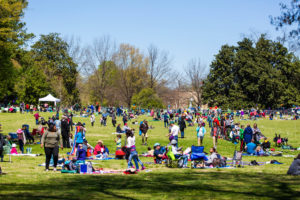OPC releases results of parking plan
 Overton Park is 342 acres of the best Memphis has to offer. That was on clear display this past weekend, when families walked together to erase multiple sclerosis, kids sprawled on the Greensward with free books from Literacy Mid-South, two rugby teams went to battle, and young soccer and golf teams learned their crafts. The air was filled with music from the Memphis Drum Tribe and the smells of delicious meals from our thriving food truck scene. Dogs bounded in Overton Bark, dozens of people enjoyed a free yoga class, and wildflowers burst into bloom in the Old Forest.
Overton Park is 342 acres of the best Memphis has to offer. That was on clear display this past weekend, when families walked together to erase multiple sclerosis, kids sprawled on the Greensward with free books from Literacy Mid-South, two rugby teams went to battle, and young soccer and golf teams learned their crafts. The air was filled with music from the Memphis Drum Tribe and the smells of delicious meals from our thriving food truck scene. Dogs bounded in Overton Bark, dozens of people enjoyed a free yoga class, and wildflowers burst into bloom in the Old Forest.
The park has a rich history (one that national audiences are about to learn), but more than that, it represents our future. In a time when we’re facing many challenges, it’s so important that we have a place where Memphians and our visitors can come together, learn more about each other, and build community. It’s a place to stretch what The Commercial Appeal’s David Waters recently called our “civic imagination.”
It’s in the spirit of exercising that imagination that Overton Park Conservancy is pleased to release the transportation and parking report created by Looney Ricks Kiss, Alta Planning + Design, and Kimley-Horn and Associates. This report brings together the ideas of Overton Park’s cultural institutions and its users, along with a thorough assessment of how to gradually eliminate the conflict between park use and demand for parking.
The report lists three phases of proposed improvements. Several of the recommendations in Phase 1–such as improving communications to park visitors–represent low-hanging fruit and are under immediate consideration. For example, adding on-street parking to N. Parkway is a solution that has already been funded and is in the planning stages.
Other recommendations, especially in Phases 2 and 3, still warrant further discussion, and this report is the starting point for those conversations. Because of the time-sensitive nature of this issue, the Conservancy asked the planning team to present a comprehensive menu of options so that the community could have a wide selection to choose from. The team recommended re-assessing the need for further improvements after each phase, to see how far each implementation has brought us.
We look forward to continuing the dialogue with our park partners and with those who use and love the park. Let’s bring our imaginations to work as we determine how best to design, fund, and implement solutions that will benefit the entire park.
Download the report and recommendations here.
Download the exhibits to the report here.
Or view the full report below without downloading (click arrow to go full-screen).



